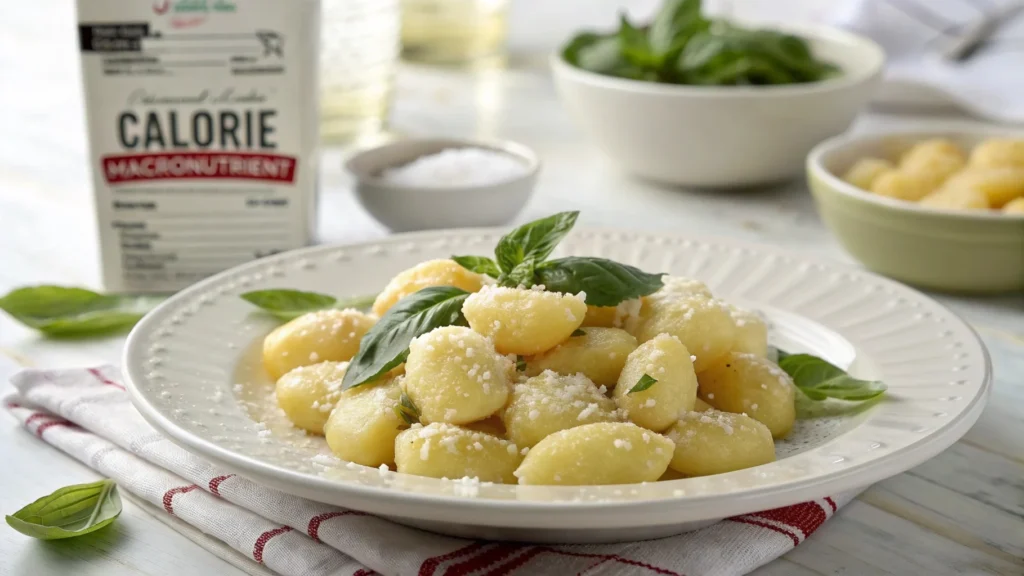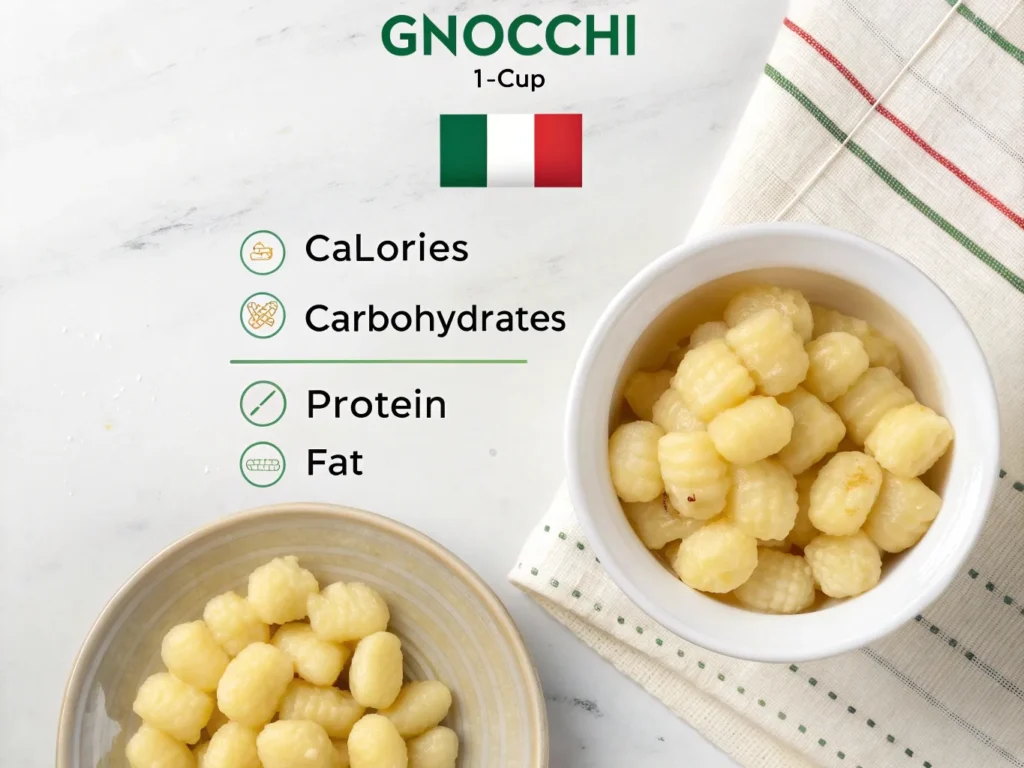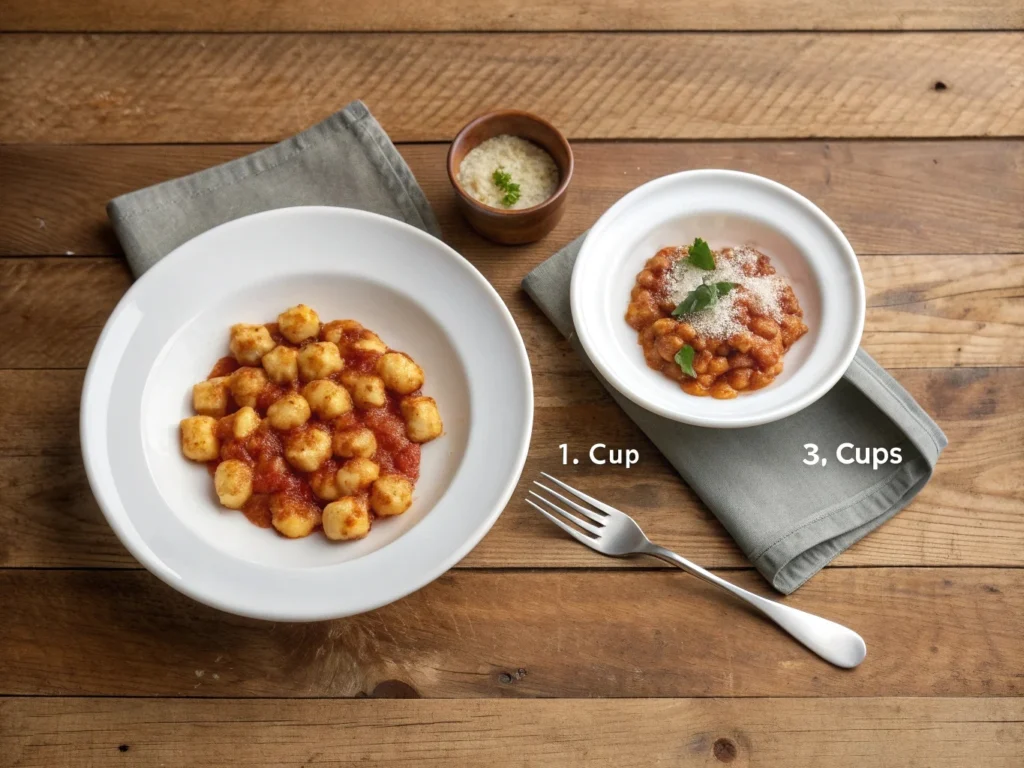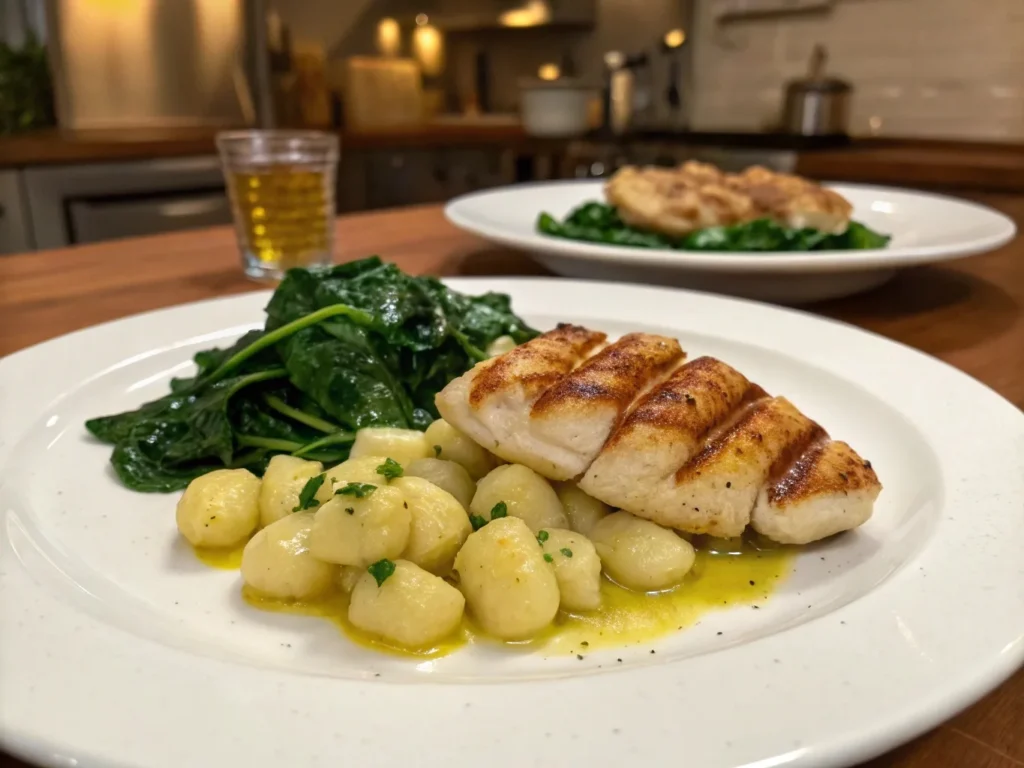Gnocchi calorie guide: discover exactly how many calories each pillowy dumpling packs—and smart ways to keep portions in check.
The first time I twirled a fork through a plate of pillowy gnocchi, I realized it was more than pasta. It was a mix of comfort and nutrition that sparked my curiosity. Learning about gnocchi calories is about making choices that are good for you. This Gnocchi Calories Guide will help you understand the nutritional impact of this popular Italian dish.
A single serving of potato gnocchi has 250 calories in 188 grams. This shows why gnocchi is more than a simple side dish. It’s a complex carbohydrate that needs careful thought.
If you’re into fitness, love cooking, or watch what you eat, this guide is for you. We’ll explore the world of gnocchi calories and how they affect your diet. We’ll look at every part of this beloved Italian dish.

Understanding Gnocchi Basics
Gnocchi is a beloved Italian dish that brings comfort and tradition to your table, but many people wonder, is gnocchi a potato or a pasta? Understanding its classification can help you appreciate its nutritional profile even more. These potato dumplings have a rich history that spans generations. Knowing the ingredients and types of gnocchi can enhance your appreciation for this dish. Our Gnocchi Calories Guide explores how different types of gnocchi impact nutrition and calorie content.
Traditional Ingredients
The classic gnocchi recipe uses simple yet essential ingredients. Yukon potatoes are the main ingredient, with about 1 1/2 pounds needed for a batch. Flour is also key, with about 1 1/2 cups used to bind the ingredients. Some recipes may include eggs for extra texture.
| Ingredient | Quantity | Purpose |
|---|---|---|
| Yukon Potatoes | 1 1/2 pounds | Primary base and texture |
| Flour | 1 1/2 cups | Binding ingredient |
| Eggs | Optional | Extra binding and richness |

Types of Gnocchi
Gnocchi comes in several delightful variations. Potato gnocchi is the most traditional type. But you’ll also find versions made from ricotta, semolina, and even pumpkin. Each type offers unique flavors and textures.
Cultural Significance
In Italian cuisine, gnocchi is more than a meal—it’s a family tradition. Making gnocchi is often a communal activity, with recipes passed down through generations. The process of creating these dumplings shows the love and care in Italian cooking.
When making gnocchi at home, remember that practice is key. The dough should rest for about 20 minutes to hydrate and relax the gluten. With patience, you can make delicious gnocchi that rivals those in traditional Italian kitchens.
Gnocchi Calories Guide: Complete Nutritional Breakdown
Knowing about gnocchi’s nutritional info is key for smart food choices. A 188g serving of gnocchi offers a balanced mix of taste and health benefits.
Each serving of gnocchi has about 250 calories. This makes it a good choice for many diets. According to our Gnocchi Calories Guide, knowing the exact macronutrient breakdown can help you make informed meal choices. The nutritional details show a mix of nutrients that add to its health value.
| Nutrient | Amount | % Daily Value |
|---|---|---|
| Total Calories | 250 | – |
| Total Fat | 12g | 15% |
| Carbohydrates | 32g | 12% |
| Protein | 4.5g | 9% |
The fat in gnocchi includes monounsaturated and polyunsaturated fatty acids. Monounsaturated fats are 2.927g, and polyunsaturated fats are 0.555g.
It’s also rich in important nutrients like Thiamin (Vitamin B1) and Vitamin A. Thiamin is 0.212 mg (18% Daily Value), and Vitamin A is 107.16 mcg (12% Daily Value). These help with metabolism and immune health.
Remember, the size of your gnocchi serving affects its calorie count. A single serving is a good balance of nutrients for a healthy diet.
If you’re curious about how to make your own gnocchi from scratch, check out this authentic Gnocchi di Patate recipe to control portion sizes and ingredients for a healthier version.
Gnocchi Calories Guide: Portion Sizes and Serving Guidelines
Knowing how much gnocchi to eat is key for a healthy diet. This Gnocchi Calories Guide provides insights into portion control to help you enjoy this dish without exceeding your daily calorie goals. A standard serving is 1 to 1.5 cups, or 188-282 grams. This helps you keep track of calories and nutrients.
Standard Gnocchi Serving Sizes and Calories
When making gnocchi at home, choose a portion that fits your diet. A 2-ounce serving has about 89 calories and 19 grams of carbs. This size lets you enjoy the pasta without overeating.

Restaurant vs. Home Portions
Restaurant portions are often bigger than what you should eat at home. Visual perception plays a key role in portion control. Restaurants might serve 2-3 times more than you need. At home, use measuring cups or a kitchen scale for the right amount.
For a well-balanced meal, try pairing gnocchi with protein-rich dishes like this Slow Cooker Tuscan Chicken Meatballs & Gnocchi recipe, which combines classic Italian flavors with a nutritious twist.
Is Gnocchi Low in Calories? A Guide for Weight Management
To manage your weight, eat gnocchi wisely. Pair it with lean proteins and veggies for a full meal. The Gnocchi Calories Guide also recommends tracking portion sizes to maintain a balanced diet. The goal is to eat in moderation and listen to your body’s needs.
| Gnocchi Serving Size | Calories | Carbohydrates |
|---|---|---|
| 1 cup (188g) | 135 | 17g |
| 1.5 cups (282g) | 203 | 25.5g |
Macronutrient Profile in the Gnocchi Calories Guide
Knowing the gnocchi macronutrients helps you make better food choices. A typical serving shows a mix of carbs, proteins, and fats.
The carbs in gnocchi are key for energy. In 100 grams, gnocchi has about 17.1% carbs, or 17 grams in a standard serving. This Gnocchi Calories Guide explains how its carbohydrate content fits into a balanced diet. These carbs give quick energy and make the dish feel filling.
| Macronutrient | Percentage per 100g | Grams per Serving |
|---|---|---|
| Carbohydrates | 17.1% | 32g |
| Fats | 6.2% | 12g |
| Protein | 2.4% | 4.5g |
A cup of gnocchi has about 40 grams of carbs. This is about 14% of the daily intake for a 2,000-calorie diet. Experts say carbs should be 45-65% of your daily calories.
Protein in gnocchi is not high, with 2.4 grams per 100 grams. But, gnocchi can help meet your protein needs when eaten with other protein-rich foods.
Fat Content and Composition
Knowing how much fat is in gnocchi is key for good eating habits. Our Gnocchi Calories Guide explores the differences between saturated and unsaturated fats in this dish. A typical serving of gnocchi has a lot of fat. This affects your daily nutrition. Let’s look at the fat in this Italian favorite.
Saturated Fat Analysis
In a standard 188g serving, gnocchi has 12g of total fat. Of this, 7.2g is saturated fat. This is about 36% of the daily value for saturated fat. So, it’s important to watch how much you eat and how often.
Healthy Fat Components
Gnocchi also has good fats. It has monounsaturated fatty acids (2.927g) and polyunsaturated fatty acids (0.555g). These fats are good for you when eaten in the right amount.
Impact on Daily Fat Intake
Managing your daily fat intake is important. Gnocchi’s fat content can take up a big part of your daily fat allowance. Eating it with lean proteins or veggies can make the meal healthier.
| Fat Category | Amount (g) | % Daily Value |
|---|---|---|
| Total Fat | 12 | 15% |
| Saturated Fat | 7.2 | 36% |
| Monounsaturated Fat | 2.927 | – |
| Polyunsaturated Fat | 0.555 | – |
Carbohydrate Content and Impact
Knowing about gnocchi carbs is key for smart food choices. A 2-ounce serving of gnocchi has about 19 grams of carbs. This is much less than regular pasta’s 43 grams. These carbs help give us energy and aid in our body’s functions.
The glycemic index of gnocchi matters for those who watch their blood sugar. Gnocchi has carbs, but how it affects blood sugar depends on how it’s made. Potato-based gnocchi has a different effect on blood sugar than wheat-based ones.
| Gnocchi Carbohydrate Breakdown | Amount |
|---|---|
| Total Carbohydrates (2 oz serving) | 19 grams |
| Dietary Fiber | 0.9 grams |
| Net Carbohydrates | 18.1 grams |
Research shows carbs affect our energy and sports performance. A study found that high-carb diets boost stamina and burn more calories during intense workouts. This makes gnocchi carbs a good energy source for the active.
For those watching carbs, think about portion sizes and how it’s made. Eating gnocchi with protein and veggies can balance its carb effect. This makes for a healthier meal.
Protein Value in Gnocchi
Knowing the protein in gnocchi helps you choose better. The protein in gnocchi changes based on what’s in it and how it’s made. Traditional potato gnocchi has a bit of protein, but some types can add a lot more.
Amino Acid Profile
The amino acids in gnocchi depend on what it’s made of. Potato gnocchi has fewer amino acids. But, gnocchi made with eggs or ricotta has more, which is better for your body.
| Gnocchi Type | Protein (g) | Amino Acid Complexity |
|---|---|---|
| Potato Gnocchi | 5 | Low |
| Ricotta Gnocchi | 22 | High |
| Egg-Based Gnocchi | 9 | Medium |
| Pumpkin Gnocchi | 9 | Medium |
Protein Quality Assessment
Not all proteins are the same. Gnocchi with ricotta or eggs is better for you. These types help build muscle better. Choose gnocchi wisely for the best nutrition.
Your protein needs change with age, how active you are, and your health goals. Gnocchi can help with protein, but don’t rely on it alone. Eat it with lean meats, fish, or beans for a full meal.
Vitamin and Mineral Content
Looking into the vitamins and minerals in gnocchi shows it’s more than just carbs. It’s a food that can help meet your daily nutrient needs.
Potato gnocchi is packed with minerals that are good for your health. Potassium helps control blood pressure and muscle strength. Iron is key for making red blood cells, which fight anemia.
Other important minerals in gnocchi are magnesium and phosphorus. Magnesium is great for muscles and nerves. Phosphorus helps with bone health and fixing cells.
| Mineral | Benefits | Approximate Content |
|---|---|---|
| Potassium | Blood pressure regulation | 200-250 mg per serving |
| Iron | Red blood cell production | 1-2 mg per serving |
| Magnesium | Muscle and nerve function | 20-30 mg per serving |
Wheat gnocchi also has vitamin B complex like thiamin and folate. These vitamins boost metabolism and energy, making gnocchi more than just carbs.
How you cook gnocchi matters for its nutrient content. Steaming or boiling keeps more nutrients than frying. This makes gnocchi a healthier choice.
Dietary Considerations and Restrictions
Gnocchi comes in many options for those with special dietary needs. Whether you’re looking for gluten-free gnocchi or vegan alternatives, knowing your choices is key to a balanced diet.
Navigating Gluten Challenges
Traditional gnocchi often has wheat flour, making it not gluten-free. For those with gluten issues, there are gluten-free gnocchi made from flours like rice, potato, or corn. These offer tasty alternatives.
Vegan Gnocchi Options
Vegan gnocchi is becoming more popular with the rise of plant-based diets. Chefs use plant-based binders instead of eggs. This way, they make vegan gnocchi that’s both tasty and true to its texture and flavor.
| Gnocchi Type | Gluten Status | Vegan Compatibility | Key Ingredients |
|---|---|---|---|
| Traditional | Contains Gluten | Non-Vegan | Wheat Flour, Eggs, Potatoes |
| Gluten-Free | Gluten-Free | Varies | Rice Flour, Corn Flour, Potatoes |
| Vegan | Depends on Flour | Vegan | Plant Flour, Potato, Binding Agents |
Alternative Dietary Adaptations
You don’t have to give up flavor because of dietary restrictions. Try making gnocchi with sweet potato, chickpea flour, or quinoa. These ingredients can help you make healthy, tasty meals that fit your dietary needs.
Health Benefits and Concerns
Learning about gnocchi’s health benefits can guide your food choices. This Italian pasta is more than tasty. It’s packed with nutrients that boost your well-being.
Gnocchi’s nutritional profile is impressive. With 289.3 calories per serving, it’s a balanced mix of nutrients. It has 8.1 grams of protein for muscle health and only 0.7 grams of fat, making it a lean choice.
| Nutritional Highlights | Amount per Serving |
|---|---|
| Calories | 289.3 |
| Protein | 8.1g |
| Total Fat | 0.7g |
| Carbohydrates | 62.2g |
| Dietary Fiber | 3.4g |
Gnocchi is rich in minerals. It has 18.9 mg of calcium and 36.8 mg of magnesium for strong bones and metabolism. The iron content at 9% of daily value helps make red blood cells.
But, there’s a concern about sodium. A serving has 660 mg, which is 28% of the daily limit. If you’re watching your salt intake, be careful with how much you eat.
Gnocchi also has antioxidants like broccoli. It’s low in cholesterol and has no artificial ingredients. This makes it a good choice for those who care about their health.

FAQ
How many calories do gnocchi have?
The calorie content of gnocchi depends on the ingredients used. Traditional potato gnocchi contains approximately 250 calories per 188g serving. However, variations like ricotta gnocchi may have slightly fewer calories, while fried or buttered gnocchi can be higher in calories due to added fats.
How many calories are in a portion of gnocchi?
A standard portion of gnocchi is about 1 cup (230g), which typically contains 300-400 calories, depending on preparation. If served with sauces like pesto or cream-based options, the calorie count can increase significantly. Opting for a tomato-based sauce or light olive oil dressing can help keep the calorie intake lower.
Is gnocchi OK for weight loss?
Gnocchi can be included in a weight-loss diet if portion control is maintained. Since gnocchi is high in carbohydrates, it’s best paired with lean proteins and fiber-rich vegetables to balance blood sugar levels and promote satiety. Opting for whole-wheat or vegetable-based gnocchi can also provide a healthier alternative.
How many calories are in 2 cups of gnocchi?
Two cups (about 460g) of potato gnocchi can contain 600-800 calories, depending on ingredients and cooking methods. If you’re watching your calorie intake, consider reducing portions or using lower-calorie variations such as cauliflower gnocchi or whole-grain options.
What is the best way to enjoy gnocchi without excess calories?
To enjoy gnocchi while keeping calorie intake in check, consider:
- Boiling instead of frying to avoid extra fats.
- Pairing with light sauces like marinara or olive oil instead of heavy cream-based sauces.
- Adding protein sources like grilled chicken, shrimp, or beans for a more balanced meal.
- Incorporating vegetables such as spinach, zucchini, or bell peppers to increase fiber and nutrients.
Conclusion
Learning about gnocchi’s nutrition can help you make better food choices. This Italian dish is not just tasty; it’s also packed with nutrients. To enjoy gnocchi in a healthy way, pay attention to portion sizes and what you pair with it.
Remember, moderation is key. Gnocchi can be a healthy part of your meals, but it’s important to balance it. Try pairing it with veggies, lean proteins, and other healthy foods. A good starting point is a 16 oz. serving with ingredients like onions, tomatoes, and garlic.
Knowing what’s in gnocchi can let you enjoy it without hurting your health goals. How you prepare it and what you add to it matters a lot. Choose whole foods, control your portions, and mix gnocchi with other nutrient-rich foods.
Your own health needs will tell you how gnocchi fits into your diet. Talking to a registered dietitian can give you advice that’s just right for you. They can help you meet your health and wellness goals.
For more delicious Italian-inspired recipes, check out this Outside-In Stuffed Gnocchi with Sauce—a creative twist on traditional gnocchi that brings exciting new flavors to your plate!
